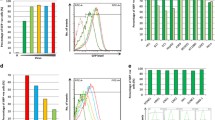Abstract
In this study, tissue-specific transcriptional activity of WT1 promoter and enhancer was investigated in a hope to design gene therapy strategy based on the transcriptional regulatory elements of WT1 gene. WT1 promoter and/or enhancer were ligated into pEGFP-1 to construct recombinant vectors with EGFP gene as a reporter and analyzed using Flow cytometry. The results showed that pEWP containingWT1 promoter induced the highest EGFP expression in ECV304 at 16.54 ± 2.45 times, mildly higher in MCF-7 and SHG44 at 9.46 ± 1.10 and 7.29 ± 0.73 times, and in K562 cell line at 2.93 ± 0.27 times, compared to that of pEGFP-1. However, pEWPA, with WT1 enhancer inserted at Afl II site, increased basal transcription levels of the WT1 promoter in HT-29, SHI-1 and K562 cells by 4.81, 3.06 and 1.01-fold, respectively. pEWPD inserted at NotI and pEWPE inserted at BamI had no ability to increase the transcriptional activity of WT1 promoter. Moreover, reporter gene silenced was observed in transfected host cells by flow cytometryt and real-time PCR. These results suggested that transcriptional activities of WT1 promoter in the recombinant vector seemed not correlated to the constitutional expression level of endogenous WT1 gene. The WT1 enhancer could promote the transcriptional activities of WT1 promoter in some of the cell lines regardless of the hematopoietic tissue origin. The inserted site of enhancer in vector influenced the transcriptional activity of promoter and the extent of reporter gene silencing exerted the influence on the analysis of transcriptional activity.




Similar content being viewed by others
References
Call KM, Glaser T, Ito CY, et al. Isolation and characterization of a zinc finger polypeptide gene at the human chromosome 11 Wilms’ tumor locus. Cell. 1990;60:509–20.
Gessler M, Poustka A, Cavenee W, et al. Homozygous deletion in Wilms tumours of a gene identified by chromosome jumping. Nature. 1990;343:774–8.
Pritchard-Jones K, Fleming S, Davidson D, et al. The candidate Wilms’ tumor gene is involved in genitourinary development. Nature. 1990;346:194–7.
Haber DA, Buckler AJ. WT1: a novel tumor suppressor gene inactivated in Wilm’s tumor. New Biol. 1992;4:97–106.
Brown KW, Watson JE, Poirier V, et al. Inactivation of the remaining allele of the wt1 gene in a Wilms’ tumour from a WAGR patient. Oncogene. 1992;7:763–8.
Gao L, Bellantuono I, Elsasser A, et al. Selective elimination of leukemic CD34+ progenitor cells by cytotoxic T lymphocytes specific for WT1. Blood. 2000;95:2198–203.
Baird PN, Simmons PJ. Expression of the Wilms tumor gene (WT1) in normal hemopoiesis. Exp Hematol. 1997;25:312–20.
Im HJ, Kong G, Lee H. Expression of Wilms tumor gene (WT1) in children with acute leukemia. Pediatr Hematol Oncol. 1999;16:109–18.
Tamaki H, Ogawa H, Ohyashiki K, et al. The Wilms’ tumor gene WT1 is a good marker for diagnosis of disease progression of myelodysplastic syndromes. Leukemia. 1999;13:393–9.
Sugiyama H. Wilms tumor gene (WT1) as a new marker for the detection of minimal residual disease in leukemia. Leuk Lymphoma. 1998;30:55–61.
Chen ZX. The possible role and application of WT1 in human leukemia. Int J Hematol. 2001;73:39–46.
Oji Y, Suzuki T, Nakano Y, et al. Overexpression of the Wilms’ tumor gene WT1 in primary astrocytic tumors. Cancer Sci. 2004;95:822–7.
Oka Y, Udaka K, Tsuboi A, et al. Cancer immunotherapy targeting Wilms’ tumor gene WT1 product. J Immunol. 2000;164:1873–80.
Ohminami H, Yasukawa M, Fujita S. HLA class I-restricted lysis of leukemia cells by a CD8(+) cytotoxic T-lymphocyte clone specific for WT1 peptide. Blood. 2000;95:286–93.
Gaiger A, Reese V, Disis ML, et al. Immunity to WT1 in the animal model and in patients with acute myeloid leukemia. Blood. 2000;96:1480–9.
Fraizer GC, Wu YJ, Hewitt SM, et al. Transcriptional regulation of the human Wilms’ tumor gene (WT1). Cell type-specific enhancer and promiscuous promoter. J Biol Chem. 1994;269:8892–900.
Zhang XH, Xing GX, Fraizer GC, Saunders GF. Transaction of an intronic hematopoietic -specific enhancer of human Wilms’ Tumor 1 gene by GATA-1 and c-Myb. J Biol Chem. 1997;272:29272–80.
Hosen N, Yanagihara M, Nakazawa T, et al. Identification of a gene element essential for leukemia-specific expression of transgenes. Leukemia. 2004;18:415–9.
Gu WY, Chen ZX, Hu SY, et al. Changes in expression of WT1 isoforms during induced differentiation of the NB4 cell line. Haematologica. 2005;90:403–5.
Kar-Roy A, Wei D, Michael N, et al. Green fluorescence protein as a transcriptional reporter for the long terminal repeats of the human immunodeficiency virus type 1. J Virol Methods. 2000;84:127–38.
Srinivasa Reddy MS, Dinkins RD, Collins GB. Gene silencing in transgenic soybean plants transformed via particle bombardment. Plant Cell Rep. 2003;21:676–83.
Moolten FL. Tumor chemosensitivity conferred by inserted herpes thymidine kinase genes: paradigm for a prospective cancer control strategy. Cancer Res. 1986;46:5276–81.
Balzarini J, Bohman C, De Clercq E. Differential mechanism of cytostatic effect of (E)-5-(2-bromovinyl)-2′-deoxyuridine, 9-(1,3-dihydroxy-2-propoxymethyl)guanine, and other antiherpetic drugs on tumor cells transfected by the thymidine kinase gene of herpes simplex virus type 1 or type 2. J Biol Chem. 1993;268:6332–7.
Ilsley DD, Lee SH, Miller WH, et al. Acyclic guanosine analogs inhibit DNA polymerases alpha, delta, and epsilon with very different potencies and have unique mechanisms of action. Biochemistry. 1995;34:2504–10.
Mesnil M, Yamasaki H. Bystander effect in herpes simplex virus-thymidine kinase/ganciclovir cancer gene therapy: role of gap-junctional intercellular communication. Cancer Res. 2000;60:3989–99.
Glienke W, Maute L, Koehl U, et al. Effective treatment of leukemic cell lines with wt1 siRNA. Leukemia. 2007;21:2164–70.
Acknowledgments
We acknowledge Dr. Gail C. Fraizer for generous provision of the plasmids. This study is supported by the grant #39770306 from the National Natural Science Foundation of China and the grant #06KJB320101 from Natural Science Basic Research of higher learning institution of Jiangsu Province.
Author information
Authors and Affiliations
Corresponding author
About this article
Cite this article
Hu, S., Chen, Z., Gu, W. et al. The transcriptional activity of WT1 gene promoter and enhancer in cell lines with diverse tissue origin. Int J Hematol 87, 498–506 (2008). https://doi.org/10.1007/s12185-008-0090-7
Received:
Accepted:
Published:
Issue Date:
DOI: https://doi.org/10.1007/s12185-008-0090-7




